Multiplo Open Source Robots Arrive
When I heard that Multiplo planned to release an open source robots kit I was very excited by the possibilities. I was excited because for once, anyone with an interest in robotics would have access to the tools they need to get involved. Most existing robotics kits use proprietary parts and the user can’t add new parts they designed. With open access to all the design files, builders can custom-make their own components or modify an existing design to fit their needs.
Another reason I was excited was because the Multiplo robots use Minibloq Graphical programming Environment for Arduino. Minibloq allows the user to use the Duinobot, Arduino compatible Brain without knowing how to write code.
What’s in the box?
Multiplo Robots (http://multiplo.org) come in 3 different levels, starter kit, building kit and Monster kit. Each kit has roughly double the amount of equipment supplied. I used the builders kit.
The Multiplo Builders kit comes in a plastic tackle box with two fold out trays. Each compartment of the tray is filled with goodies. My kit included two geared DC Motors, Duinobot controller, 2 r/c servos, infrared remote, five different kinds of sensors, cables, wheels and lots of building blocks and hardware. There is enough equipment to build a fairly complex robot.
Building with Multiplo
Building with the Multiplo robot system is very fast and easy. Making things with Multiplo is not like making things with Lego, it’s more like making things with an erector set. There are a series of plastic pop rivets (PPR) to hold the building blocks together. Each building block has a series of holes evenly spaced 9mm apart on them. You insert the plastic pop rivets through the holes and then push down on the head of the PPR to close them. By combining aluminum brackets with the plastic building blocks and PPRs you are able to create a variety of platforms. If you make a mistake just flip that part over and pushed downward on the PPR to open it up again. The PPR are reusable and quickly replaceable. The PPRs are color coded for size and ease of identification.
Building with the Multiplo systems is not hard, but it does take attention to detail. You have to pay attention to where you place the plastic pop rivets in relation to the aluminum brackets and other components. If you make a mistake it’s very easy and quick to disassemble and correct your errors.
ROBOT PROJECT ASSEMBLY GUIDES
There are several robot project assembly guides available online. These projects include detailed drawings and pictures that show each step of the construction. Detailed drawings shows how to assemble the building blocks. The drawings show a red dot wherever a plastic pop rivets goes. The assembly drawings are color coded to show you which length of PPR to use.
When you use the assembly guides, use the drawing on the left side to see where to insert the plastic pop rivets into the bottom of the building block. Then place the second building block over the first one using the red dots on the right hand drawing to tell you how to align it. The drawings on the right side are for one side of the vehicle. Everything on the left side is for the other side of the vehicle. This could be confusing at first because there is no text in the instructions.
WHAT TO BUILD?
I decided to build the Three Wheeled Robot project to become familiar with the Multiplo system. I followed the instructions on the included CD but you should check the website for the latest updates before you get started.
There are several online robot building guides to choose from. You can use the designs as the basis for your own design work or simply build them as designed. I wanted to quickly become familiar with the building process so I just used one of the existing designs.
LET’S BUILD
I began to mount components to the plastic building blocks using the plastic pop rivets, metal brackets and metric screws. Small components quickly build into larger assemblies.
One really neat feature of this robot is the flip top battery pack. I constructed a little arm from some brackets and building blocks. The arm pivots in a hole in the side of a building block. It makes maintenance of the batteries and Brain convenient.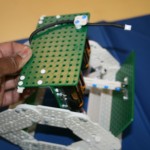
The kit included two planetary gear drives attached to 12 V DC motors. The two motors are used to propel the robot across the floor and for steering. The motors attach to the included knobby tires and hubs (similar to an off-road R/C car tire). The wheel hubs are little complicated to build but work well.
THE CLAW!
Building the gripper claw is probably the most complex part of the build and the one that takes the most attention to detail. I found that I had to disassemble the parts a couple of times to get the assembly right. I didn’t look closely enough at the picture so I missed some things that weren’t evident like flat washer and lock washers in certain assemblies. I eventually got it right.
TIPS FOR BUILDING THE CLAW
• The Claw gear box uses three aluminum standoffs, a 40 mm screw, washers and a wheel collar to hold it in place. Also the secondary gear is not centered in gear box rectangle.
• Another thing I missed while building the gripper claw was that you need to stack two gears together to make the free-floating side of the claw. If you don’t use two gears then things won’t line up correctly.
• When you make the claw arm use the black plastic pop rivets instead of the gray ones. They will close better. I also used the black PPRs to mount the claw arm to the sides of the chassis. The gray ones are not quite long enough to make it easy to mount. Another thing to watch out for is when you’re mounting the steel rods for the gripper claw. It’s easier to slide the entire bar through all the holes with the appropriate wheel collars in place. If you try to spread the arms out to fit over the chassis sides it just doesn’t work very easily.
• When you mount the pressure sensors and sonar, it’s a good idea to plug in the cables before you bolted them to the building blocks.
RUNNING OF THE BOTS
Once I finished the 3 wheeled bot it was time to program it. Or was it? You see the Multiplo Builders kit comes with a pre-programmed Duinobot brain. All I had to do was install all the cables to the correct ports, put batteries in the Remote control unit and begin.
The program loaded on the Duinobot will not control the claw unit but it will control the e motors and steer the robot around. If you want to control the claw you can download a program from the forum to do it or write your own program.
http://multiplo.org/participate/talk/#/discussion/35/arduino-3-wheeled-robot-improved-code-example
Steering the robot is done with the numeric keypad of the remote. To go forward, press the 2 button. To go backwards, press the 8 button. Pressing the 4 and 5 buttons will make the bot rotate left or right. To stop, just press 5. Within minutes anyone can learn to steer this robot.
Conclusion
Multiplo delivered on their promise to bring an Open Source Robot building system to the market. The system is well thought out and well executed. The one area that could use some more attention is the documentation. There needs to be a step by step guide for the absolute beginner. Once this is created the Multiplo system could take on any comers.
If you would like to know more about the Multiplo building system, go to http://multiplo.org/ If you would like to download a free copy of the Minibloq Graphical Programming Environment, or sign up for the Minibloq updates newsletter.
[tubepress mode=”tag” tagValue=”multiplo robot” playerLocation=”popup” resultsPerPage=”8″]
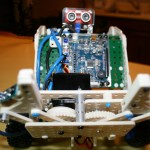
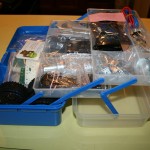
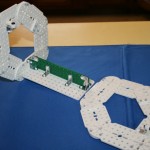
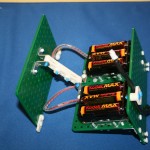
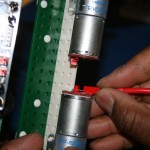
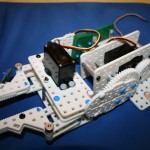
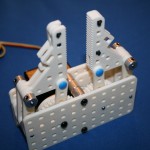
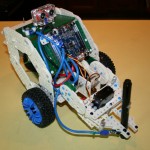

Hey, I’ve started using these kids in a class I teach. I would agree on all your points. The documentation does need more details, and prepared lesson plans would save a lot of time (I’ve done a few from scratch and am doing more.as well as new designs for lessons with younger kids). As teachers start doing more I’m hopeful that documentation will get better and more details provided. I have seen success in working with kids with these kits and I think these relate to more real world robotics than the Lego kits so far.
Jonah thanks for taking an interest in teaching our children. The Multiplo kits have a great potential to make it easier for kids to understand robotics. Please feel free to share any of your discoveries.
[…] Open Source Robots […]
Hey Bill, thank you for sharing your knowledge in both the CNC machines and the Multiplo robotics kits. I love learning about how different products work and I’ve been fascinated about CNC machines since the first time I saw one etching any logo, design or a photo onto marble tiles back in the late 90’s at an Expo in Las Vegas. I haven’t been following DIY kits for robotics but watch my nephew at his robotics competitions online. I like doing woodworking and need a wood lathe to turn the hundreds of chunks, pieces and logs, stumps or large branches and burls that need to be cut down to turn someday. I also have stacks and piles of roughsawn lumber of many species in our area. I have 30-40 logs at sawmill and at least twice that in my yard, the fields and woods that I need to get to the mill to be cut. I need to cut down or cut many trees up and haul out of my woods that a couple tornados and some high winds have blown down or snapped off, but I am disabled with constant pain from head to toes some nerve issues, bulged and herniated discs, spinal stenosis, depression, anxiety, fatigue, and nonepileptic seizures, digestion issues, etc. I’m not complaining because I know all of my health problems are gifts from God as is his son Jesus, my loving wife and son and being able to look out the window at the beauty and creatures he created as well as being able to go outside and lose myself working in the woods, fields and searching for Indian artifacts and stones and minerals in our creeks and fields.( one of my other hobbies) The problem is, I’ve been cleaning up downed trees for 10 years and the same to finish setting up 2 workshops so I can set up my equipment to do wood projects in an efficient manner. I spend 70%+ of my life in my adjustable bed because I can’t stand or sit very long at all. I write down ideas; wood projects, new products, jokes, quotes, poems, lyrics, ideas to write a book or novel, how to make a product better or easier to use, plans on where to place or store hand tools and accessories, planting trees and plants, gardening and projects for outside, etc. I also search the web for how to build or repair a machine, my health concerns and my ADHD takes me on a tour all over the Internet when I only wanted to look up how to build my own CNC machine. Bill, do you have any up to date information on the topics you cover? Gods Peace and Thank you again. James